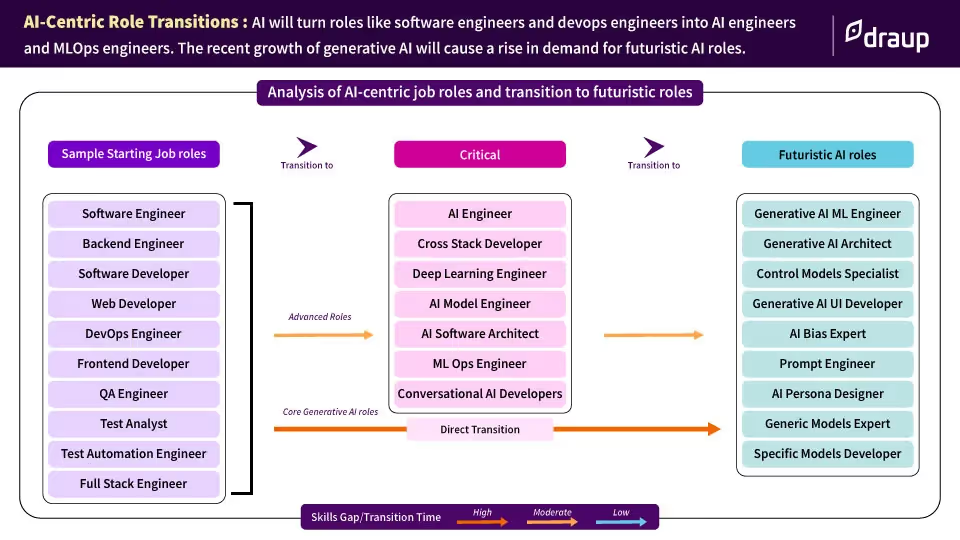Analysis of the Global Generative AI Tech Talent
Generative AI, which includes Generative Adversarial Networks (GANs) and Transformers, has transformed the way we create content, interpret data, and interact with machines.
To understand the global Generative AI tech talent landscape, we must delve into the current scenario, the geographic talent distribution, and the skill sets to excel in this dynamic field.
Generative AI is making waves across industries:
- Generative AI is generating synthetic images that help train AI algorithms for disease detection and diagnosis and develop personalized medicine and genomics research.
- The film and gaming sector is creating lifelike characters, scenes, and dialogue, ushering in a new era of interactive storytelling and gaming experiences.
- Generative AI has improved chatbots and automated content generation capabilities. It has made natural language understanding and generation more human-like.
- Financial institutions are using Generative AI for financial forecasting, fraud detection, and algorithmic trading, risk management, and make data-driven decisions.
- Generative AI is invaluable in data augmentation, a crucial process for enhancing the quality and diversity of datasets used to train AI models for more accurate predictions.
- Content recommendation systems on platforms like Netflix and Spotify rely on Generative AI to provide users with highly personalized content suggestions.
Several organizations, namely, OpenAI, Google DeepMind, Facebook AI Research (FAIR), and Microsoft Research are contributing to the GPT series, reinforcing generative models, recommendation systems and conversational AI respectively.
Academic Institutions such as Stanford University, MIT, and the University of Montreal are also contributing.
Behemoths like Amazon, Netflix, and Meta are hiring top AI talent with payscales in seven figures. This trend is illustrated by Netflix‘s $900,000 offer for AI Product Manager and by Capital One‘s high salary for Generative AI Engineers.
Certain regions have emerged as Generative AI R&D hubs:
- Silicon Valley, USA remains a major hub with numerous tech giants and startups. New York, Seattle, Mountain View, San Jose, and Denver are close behind.
- China, particularly Beijing, has made significant strides in Generative AI research. Chinese tech companies are developing cutting-edge Generative AI technologies.
- Toronto, Canada, with prominent institutions like the Vector Institute, has become a hub for Generative AI research, particularly in the NLP realm.
- London, UK: London’s academic and research institutions are pioneering Generative AI research, contributing to advancements in the field.
- Bengaluru, India: India, with its tech ecosystem, is contributing to Generative AI, in the data augmentation and NLP realm.
- Berlin, Germany has institutions like TU Berlin and MPI conducting research in informatics, focusing on GANs, NLP, and computer vision.
Generative AI Talent Landscape and Distribution of Talent
The top 5 industries among the 250+ companies that are actively hiring for Generative AI tech talent are technology, financial services, automotive, pharmaceutical, and education.
There are over 29,000 companies in the AI tech sector, but less than 1% of them specialize in Generative AI.
Retail, travel, biotech, and e-commerce are yet to see an increase in Generative AI hiring. Consulting firms like Deloitte and Accenture are hiring AI consultants which is a sign of focus on Generative AI consulting services.
While San Francisco lead in Generative AI talent, Bangalore, India, has the second-largest talent pool.
India and Brazil are hiring three times as many AI workers as they were in 2017, and both countries feature on the top 50 list. This growth rate is higher than that of the United States.
Bangalore can lead the way in Generative AI due to its suitable environment for AI-driven developments and its start-up ecosystem which fosters creativity and growth of revolutionary concepts, making it a perfect destination for cutting-edge Generative AI applications.
Moreover, cities in the USA offer the most lucrative salaries. The highest wages are available in San Francisco, New York, Mountain View, and Seattle with highest average salaries overall.
European cities sit halfway providing favorable wages to Generative AI tech professionals, whereas Bangalore offers significantly lower compensation than other locations.
Outlook of the Global Generative AI Talent
Professionals who can bridge the gap between AI and specific industry domains will be sought after. Experts in Generative AI techniques and applications, such as 3D modeling or generative art, will have unique career opportunities.
Combining multiple Generative AI models, such as GANs and transformers, will lead to more powerful and versatile AI systems from creative content generation to complex decision-making.
Federated learning, which allows AI models to learn from decentralized data sources while preserving data privacy, will enable AI to operate in sensitive data environments, including healthcare and finance.
Advancements in natural language understanding will make AI systems even more proficient at conversation, content summarization, and language translation, leading to more effective virtual assistants and language models.
However, there is a shortage of Generative AI talent with in-demand and future skills. Reskilling can bridge the skills gap.
This graphic is a representation of Draup’s analysis of bridging the skills gap to help your workforce stay current.

Reskilling enables professionals to play roles in the development, ethics, and governance of Generative AI.
AI-powered talent intelligence platform Draup for Talent offers in-depth insights into talent initiatives across sectors.
It provides talent insights across global Generative AI talent hotspots. Talent management teams can leverage vital information on talent size, cost, ecosystem maturity, and many other insights to accomplish strategic goals.
They can gather information on talent qualities in a specific area, react to changing circumstances and join the diversity and reskilling bandwagon.




.svg)




.svg)
